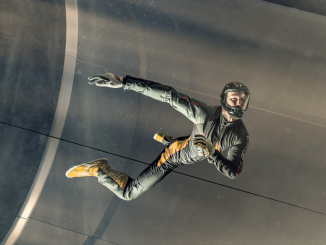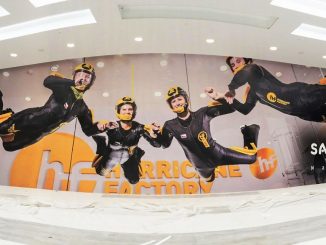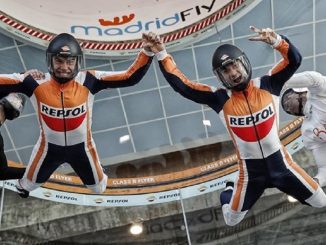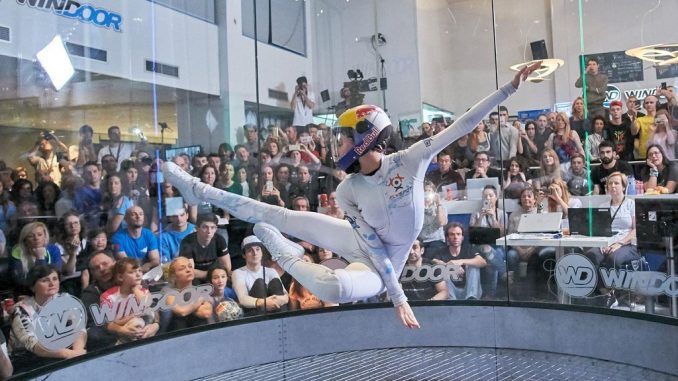
Obviously, the number one reason you should try indoor skydiving is because it’s fun. But there are a lot of other mental and physical benefits you can gain from a skydiving practice. These range from increased confidence to getting a great workout, and everything in between. For younger flyers, indoor skydiving is a fun way to stay fit, make new friends, and get involved in a unique competition sport (more on that later).
The other primary reason for getting into a groove with indoor skydiving is to improve your skydiving skills for high-flying altitude jumps. You see, jumping out of a plane only gives you about 50 seconds or so of time in free fall. It takes professional skydivers a lot of jumps to get to the level of skill that they aspire to.
Augusto Bartelle & Dusty Hanks at iFly Utah
Traditionally, a competitive skydiver has completed hundreds, maybe even thousands of jumps to advance to the skill level that puts them at the top of their sport. With indoor skydiving, a free fall experience can last blocks of 10, 15, 30 minutes or more.
Do you want more reasons to try indoor skydiving?
Ok. Here we go. Fly time is virtually unlimited so a skydiver can get in the equivalent of hundreds of dives in a fraction of the time it would take if they were jumping out of a plane each time. Not only does this help them train, but it also keeps their jump frequency up, which keeps them safer overall.
There are plenty of environmental conditions that limit when you can skydive outdoors- rain, wind, nighttime. Not so with indoor skydiving, where the environment is controlled, and you can fly anytime the facility is open for business. Not to mention, indoor skydiving safety is so high that children as young as three years old can skydive indoors.
What is Indoor Skydiving?
Most of fantasize about flying freely. It’s the superpower almost everyone would choose. Skydiving is as close as any of us ever come to genuinely flying, but not everyone is ready to jump out of a perfectly good plane, which is why indoor skydiving is so cool.
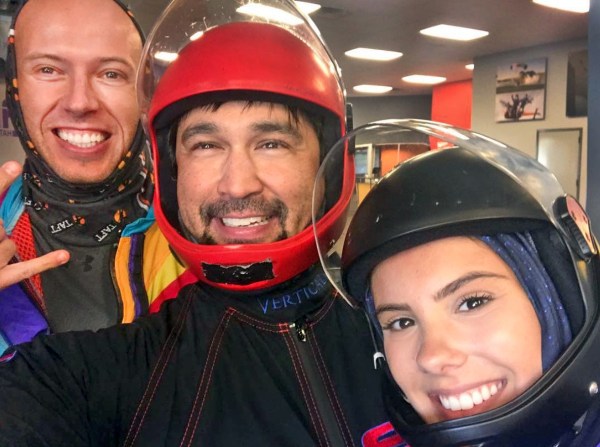
Indoor skydiving lets your body fly freely on a column of air in a vertical wind tunnel, without ever having to jump out of a plane or put a parachute on. Strong vertical wind inside a tunnel exerts the same types of forces on your body as the freefall part of a skydive.
Crazy, right? Even if you’ve been skydiving, you might still have some questions about how this experience works– so read on.
The feeling of indoor skydiving
The first time you jump out of a plane, you go directly from flying at altitude inside a plane to hurtling through the air outside the plane. When you think rationally about it, you believe that the adrenaline rush of fear is so powerful and the free-fall so brief, it can be hard to separate the freedom of flying from the rush of fear and relief and some question about skydiving can come up. However, this is not true, the real skydiving experience is a little different. I understand that once we are outside the door, we will have one of the most beautiful and remarkable experiences of our lives.
With indoor skydiving, you can focus entirely on the bodily sensation of floating and flying without the obligation to jump off from a perfect airplane. There is no feeling like it, and you just have to experience it for yourself.
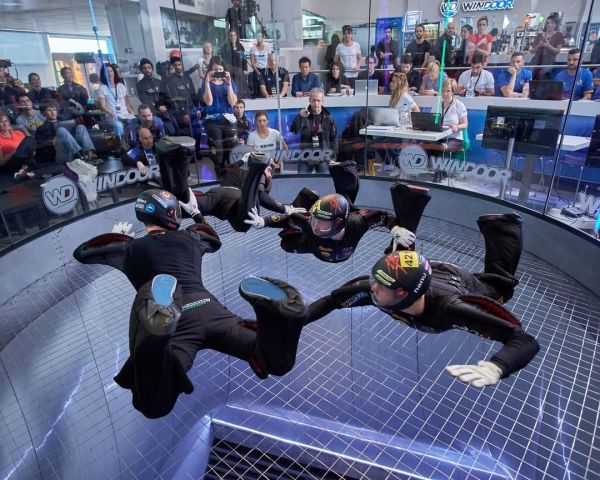
Meanwhile, be warned that it is very loud in the wind tunnel and because of this you should not forget to wear earplugs. You will communicate with your instructor through hand signals that you will learn in the class before you fly.
The Indoor Skydiving Experience
I recommend arriving at the tunnel for check-in early so you have the chance to watch other people flying and can get a taste of what it will be like. Also, you don’t want to be late, because missing the introductory class could make you lose your flight! Just like regular skydiving, the indoor skydiving experience begins in a classroom, where an instructor introduces first-time flyers to all the basic things you need to know for your first flight.
Once the class is out, you will gear up in the same gear skydivers use, minus the parachute. You will be provided with a jumpsuit, helmet, goggles, and earplugs. You should be wearing comfortable clothes (the jumpsuit goes over them), and if you have long hair, bring a hair-tie to make sure it is tied back under your helmet.
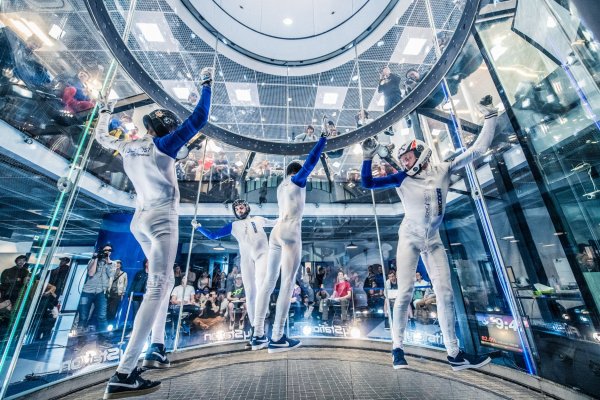
Once it is fly-time, your instructor will join you in the tunnel at least twice for one-on-one sessions where you will learn the basic maneuvers and be allowed to fly on your own. There will be photo and video offered so that you can immortalize this first flight experience, and trust me, you should– the pictures will always bring a smile to your face.
Indoor Skydiving Safety
As hard as it is to believe, indoor skydiving is probably safer than most high-impact or contact sports. Indoor skydiving accidents are generally minor and are very rare. Of course, there is some risk of getting bruised from running into the tunnel walls, but the presence of instructors and introductory training is designed to keep flyers safe.
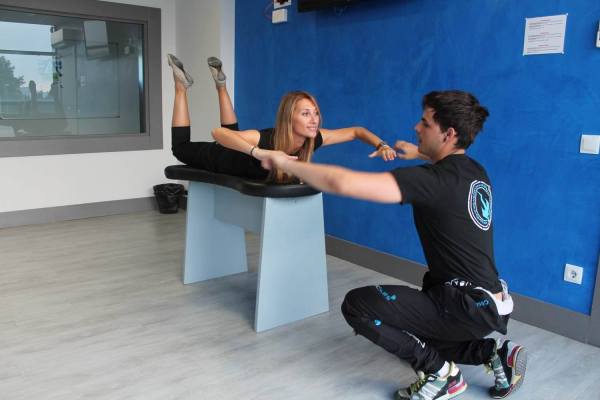
The International Bodyflight Association (IBA) now supports over 11,000 flyers and coaches all over the world, in over 60 wind tunnels. They have established safety standards for the industry.
And offer a lot of online resources for people that want to learn more. The fact that indoor skydiving is considered safe for children as young as 3 years old, and adults up to 275 lbs (except for those wearing casts or pregnant) should demonstrate just how safe an activity it is.
Indoor Skydiving Competitions
It isn’t tough to imagine getting hooked on indoor skydiving and wanting to dig in and learn more. There are so many skydiving skills you can attain beyond basic belly-diving: back diving, barrel rolling, back and front flips– you name it.
The more you learn, the more fun and challenging it becomes. And if along the way, you decide that you want to take it to the next level, there are plenty of ways to get into indoor skydiving competitions.
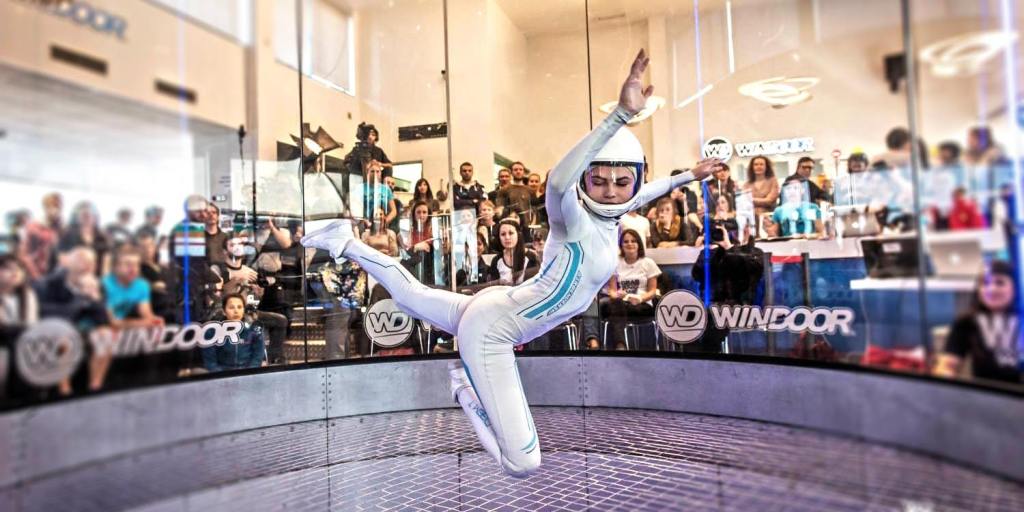
An excellent way to start is with small competitions hosted by your local tunnel. From there, if you decide that you want to do bigger competitions, you can continue training, entering events, and eventually work your way up to international level competitions, hosted annually by the World Air Sports Federation.
Indoor Skydiving Prices
Most indoor skydiving locations charge around $60 for a first-time flyer, which will give you 2 minutes of fly time.
There are many different packages these businesses offer from extra minutes to package deals for repeat visits. While the price tag on indoor skydiving might seem steep, if you take a moment and compare it to an outdoor skydiving package, you will quickly see what great value it offers.
But remember, this isn’t just 2 minutes in a wind tunnel you are paying for: it’s a life-changing experience. For 2 minutes, you will finally achieve your fantasy of defying gravity, of flying like a bird- without ever even having to jump out of a plane!
Indoor Skydiving Near Me
So, at this point, you are probably asking yourself, “Where is the indoor skydiving near me?” Good question. Just jump to our wind tunnel finder.
The bottom line is that indoor skydiving can give you a fantastic flight experience if you aren’t quite ready to commit to jumping out of a plane, and if you are already accustomed to jumping out of planes, it offers a year-round alternative for intensive skills training no matter what the weather.
I hope that you can find your way to a wind tunnel near you and experience the pure excitement of body flight. No matter who you are and what your skydiving goals, this is one experience you won’t regret.
Words by Augusto Bartelle

